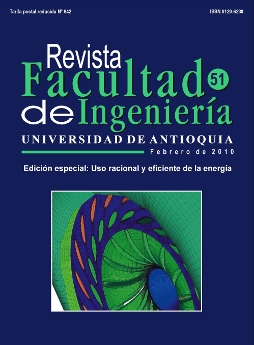Análisis multiobjetivo a un sistema energético
DOI:
https://doi.org/10.17533/udea.redin.14919Keywords:
Multiobjetivo, optimización, termoeconomíaAbstract
Se presenta una metodología reciente para optimización de un sistema energético complejo introduciendo factores externos, basada en el desarrollo de fronteras Pareto -óptimas a partir de algoritmos evolutivos multiobjetivos (AEMO) empleados en la resolución de problemas energéticos reales de optimización no lineal. Se incluyen objetivos: termo-económico, tecnológico y ambiental, a los cuales se les asigna un peso para evaluar la función de aptitud, formada por una suma de promedios de cada objetivo. El sistemaenergético complejo está formado por un ciclo combinado (subsistema I) y un gasificador (subsistema II). El desempeño de los pesos en cada objetivo se modela por reglas heurísticas, mientras que las modificaciones de las variables de decisión se basan enaplicaciones aleatorias. La metodología expuesta, permite evaluar funciones objetivo formadas por costos del combustible, costos variables de operación y costos de mantenimiento, los cuales están incluidos en la ecuación de capital de inversión. Las metas en la optimización del sistema global son minimizar los costos del producto, minimizar los residuos de la combustión y maximizar la eficiencia exergética.
Downloads
References
P. K. Sahoo. “Exergoeconomic Analysis and Optimization of a Cogeneration System Using
Evolutionary Programming.” Applied thermal engineering. Vol. ? 2007. pp.
A. Lozano, A. Valero. “Theory of the Exergetic Cost.” Energy. Vol. 18. 1993. pp 939 - 960. DOI: https://doi.org/10.1016/0360-5442(93)90006-Y
A. Bejan, G. Tsatsaronis, M. Moran. Thermal Design and Optimization. Ed. Jhon Wiley and Sons, Inc. New York. 1996. pp.
G Tsatsaronis. Thermoeconomic Analysis and Optimization of Energy Systems. 1993. DOI: https://doi.org/10.1016/0360-1285(93)90016-8
G. Tsatsaronis, J. Pisa. “Exergoeconomic Evaluation and Optimization of Energy Systems – Application to the CGAM Problem.” Energy. 1994. DOI: https://doi.org/10.1016/0360-5442(94)90113-9
R. Garduno-Ramirez, K.Y. Lee. “Multiobjective Optimal Power Plant Operation Through Coordinate Control with Pressure Set Point Scheduling.” IEEE Transactions on Energy Conversion. Vol. 16. 2001. DOI: https://doi.org/10.1109/60.921461
B. Galvan, D. Greiner, G. Winter. “Una Comparativa de Algoritmos Evolutivos Multicriterio en Diseños de Sistemas de Seguridad”. Segundo Congreso Español de Metaheurísticas, Algoritmos Evolutivos y Bioinspirados. MAEB03. 2003.
A. C. Caputo, P. M. Pelagagge, P. Salini. “Heat Exchanger Design Based on Economic Optimisation.” Applied Thermal Engineering. Vol 28. 2008. pp. 1151- 1159. DOI: https://doi.org/10.1016/j.applthermaleng.2007.08.010
K. Deb, A. Pratap, S. Agarwal, T. Meyarivan. “A Fast and Elitist Multiobjective Genetic Algorithm: NSGAII,” IEEE Transactions on Evolutionary Computation. Vol. 6. 2002. pp. 182-197. DOI: https://doi.org/10.1109/4235.996017
V. Manzur. “Fuzzy Thermoeconomic Optimization of Energy-Transforming Systems,” Applied Energy. Vol 84. 2007. pp. 749-762. DOI: https://doi.org/10.1016/j.apenergy.2007.01.006
C. Giannantoni, A. Lazzaretto, A. Macor, A. Mirandola, A. Stoppato, S. Tonon S. Ulgiati. “Multicriteria Approach for the Improvement of Energy Systems Design.” Energy Vol. 30. 2005. pp. 1989-2016 DOI: https://doi.org/10.1016/j.energy.2004.11.003
National Energy Technology Laboratory (NETL). Gasification Alternatives for Industrial Applications. United States Department of Energy. EUA. 2007.
L. Duan, Y. Yang, “Comparative Study on Different IGCC Systems with Quasi-Zero. CO2 Emission.” Int. J. of Thermodynamics. Vol. 10. 2007 pp. 61-69.
S. Alvarado, C. Gherardelli. “Input-Output Exergo- Economic Optimization of Multicomponent-Multiproducts Systems Methodology.” Energy. Vol. 19. 1994. pp 251-258. DOI: https://doi.org/10.1016/0360-5442(94)90064-7
Downloads
Published
How to Cite
Issue
Section
License
Copyright (c) 2018 Revista Facultad de Ingeniería

This work is licensed under a Creative Commons Attribution-NonCommercial-ShareAlike 4.0 International License.
Revista Facultad de Ingeniería, Universidad de Antioquia is licensed under the Creative Commons Attribution BY-NC-SA 4.0 license. https://creativecommons.org/licenses/by-nc-sa/4.0/deed.en
You are free to:
Share — copy and redistribute the material in any medium or format
Adapt — remix, transform, and build upon the material
Under the following terms:
Attribution — You must give appropriate credit, provide a link to the license, and indicate if changes were made. You may do so in any reasonable manner, but not in any way that suggests the licensor endorses you or your use.
NonCommercial — You may not use the material for commercial purposes.
ShareAlike — If you remix, transform, or build upon the material, you must distribute your contributions under the same license as the original.
The material published in the journal can be distributed, copied and exhibited by third parties if the respective credits are given to the journal. No commercial benefit can be obtained and derivative works must be under the same license terms as the original work.










 Twitter
Twitter